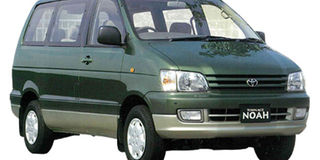Prime
The Noah is non-discriminatory

The Toyato Noah is a seven seater. PHOTO /ISAAC SSEJJOMBWE
What you need to know:
The Toyota Noah was manufactured in 2001, 2006 and 2014 respectively. It comes in the Toyota Noah Hybrid X and Y, Toyota Noah Field Tourer and Toyota Noah TownAce formats, among others, writes Roland D. Nasasira.
Gerald Niwagaba
In terms of carrying capacity, the Toyota Noah can be compared to the Super Custom. The difference is that the Noah is smaller in size and shape compared to the Super Custom.
Being a Toyota that runs on a relatively manageable engine size of 2000cc, I find it affordable to maintain. I stay in Mpererwe and work in the city centre and I spend between Shs80,000 to Shs100,000 in a week.
This weekly fuel expenditure can either increase or reduce depending on the movements I make within and outside the city centre outskirts and traffic jam to and from home. On average, I spend between Shs300,000 to Shs450,000 in a month.
The cost of service and maintenance is as manageable as that of fuel. I service after driving every 5,000km as recommended on the service manual and I spend averagely Shs250,000 to replace engine oil, oil filters, air cleaners, spark plugs and a few other parts. When I have to replace parts such as tyres, it costs a lot more because one tyre can cost as much as Shs180,000.
The beauty about the Noah is that it can never break down along any road and you fail to get a mechanic to help you out. It has basic technology any mechanic can understand to repair, unless a particular spare part has lived its lifespan and needs replacement.
David Mukwaya
I have driven my Toyota Noah Field Tourer for approximately eight years. Its full-time four wheel drive system (4WD) allows me drive on any slippery marrum road without worry of getting stuck or skidding. It runs on a four-cylinder 2000cc engine size.
In terms of carrying capacity, it is a seven or eight seater van, including the driver.
On the road, it uses one litre of fuel to cover a distance of six to eight kilometers regardless of whether it is a tarmacked or dirt road. The downside of the car is that it consumes more fuel because of its full-time 4WD system.
When driving on a murrum road and I go beyond 120km/hr, it starts to shake or vibrate and becomes uncomfortable. This is quite different when driving on a tarmacked road where I can drive above 120km/hour and it remains stable.
Away from office work, I am also a farmer and I use this car to carry chicken feeds. During times of tragedy (loss of a loved one), I use the car to transport the coffin because its rear seats can be bent to create space that stretches from the boot door to the driver’s seat.
I run a retail shop and I use the car to transport merchandise from wherever I buy it to the shop. It can carry up to 1,650 kilogrammes.
Since I bought the car in 2013, it has never broken down. I spend a lot of money to maintain it because I do not drive it above the recommended service mileage.
It’s the secret why I have kept in on the road for long. If any of its parts shows a warning sign of breaking down, I do not panel beat.
I replace it immediately and it is the reason it looks newer than vehicles with the latest number plates.
Peter Mugerwa
I have been driving the Toyota Noah for three years now. I bought a front wheel drive because I wanted a multipurpose car that I could comfortably drive even without losing engine power but also consume less fuel. It was hard for me to make a choice between the Toyota Regius, Noah and the Super Custom but I zeroed down on the Noah because of its small size.
Its on and off-road performance and capability is admirable for a family car like a Noah even when you think you have overloaded it. On a highway, it normally gives me between nine to 12 kilometres per litre of fuel but this is determined by how I accelerate.
It is a non-discriminatory car depending on if you choose to use it as a family car for weekend getaways, a daily office car or even a cargo van.
One of the downsides is that it is vulnerable to vandalism by car spare part snatchers especially when you park it along the street in Kampala.
I don’t recall how many times I have replaced the side mirrors and wheel caps before I settled for sport rims.
I mostly drive the Noah over the weekend when I am going out with my family and rarely drive it during week days, unless my other car (Toyota Harrier) is at the garage. On average, I spend Shs200,000 to have minor service done with the Noah. This is in approximately three months. I mainly top up the engine coolant, replace engine oil and transmission fluid and other important car lubricants. I get the spare parts from Kisekka Market and other garages around Wandegeya.




